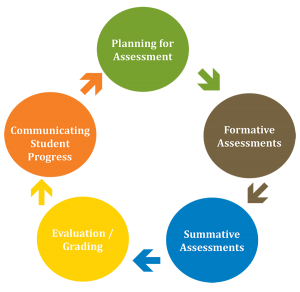
Principle #6
Summative assessments must be based on clear criteria (aligned to core competencies and learning standards) and include a variety of opportunities for students to demonstrate their learning.
“Students should have frequent opportunities to demonstrate their understanding through an assessment format that allows them to use their learning strengths. A balanced assessment plan includes a range of summative assessment formats so that students who are not strong in one format will not be disadvantaged.”
—Hume, 2010
Summative assessments are generally done at the end of the unit of learning to document achievement levels of the students. These assessments are based on clear criteria and are designed to provide information, by confirming the knowledge, skills and understanding that has been attained throughout the unit of instruction. These assessments of learning demonstrate to what extent the student has met the learning standards. Summative tasks do not have to be always high stakes.
Measurement of a student’s performance in relation to the learning standards needs to be based on clearly established criteria that describe what successful attainment of the learning goals looks like, and identifies the specific aspects of student performance that are to be assessed and/or evaluated. These criteria form the basis of evaluative rubrics, which provide clear performance indicators for varying levels of understanding and proficiency. Clearly defined criteria that is aligned with the learning targets enable defensible, judgement-based evaluation.
Summative tasks come in many shapes and sizes. To determine the best summative tool, teachers could ask themselves how students could best demonstrate their knowledge and understanding of the competencies. Performance tasks are an example of a summative assessment that allows students to demonstrate their knowledge, understanding and proficiency of learning in a tangible product. For further information on developing performance tasks, visit the Curriculum HUB.
ASSESSMENT CYCLE

TRY THIS
Click here for ideas to try in the classroom
1) Create a summative assessment that focuses on student learning.
2) Create the criteria for the summative assessment with the class.
3) Relate the criteria directly to learning targets.
4) Keep learning targets and success criteria visible in the classroom.
5) Give the students a variety of formats to demonstrate their learning.
6) Celebrate learning at the end of the unit by giving students the opportunity to share their products.
7) Use Webb’s Depth of Knowledge to create some higher level tasks at .
8) Visit the NVSD 44 Curriculum Hub for more information on developing performance tasks.
WATCH THIS
Click here to watch related video content
John Hattie: Learning Intentions and Success Criteria
John Hattie explaining the importance of Learning Intentions (targets) and Success Criteria together.
A Group Critique Lesson
EL Education’s Ron Berger leads a group critique lesson with students from the Presumpscot School in Portland, ME. The third-graders use a piece of student writing as a model from which to identify criteria for a quality story.
READ THIS
Click here for additional reading suggestions
To learn more, check out these texts:
- Cameron, C., and Gregory K. (2014). Rethinking Letter Grades: A Five-Step Approach for Aligning Letter Grades to Learning Standards. 2nd Edition, Winnipeg, Portage and Main Press.
- Crockett, L. and Churches, A. (2017). Mindful Assessment: The 6 Essential Fluencies of Innovative Learning. Bloomington, IN, Solution Tree Press.
- Moss and Brookhart (2012). Learning Targets, ASCD, Alexandria, VA.
- McTighe, J. & Wiggins, G. (2014). Improve Curriculum, Assessment and Instruction Using Understanding By Design Framework. Alexandria: ASCD.
- Wiliam, D. & Black, P.J. (1996). Meanings and consequences. In H.L. Andrade & G.J. Cizek (Eds.), Handbook of formative assessment. New York: Taylor & Francis.
